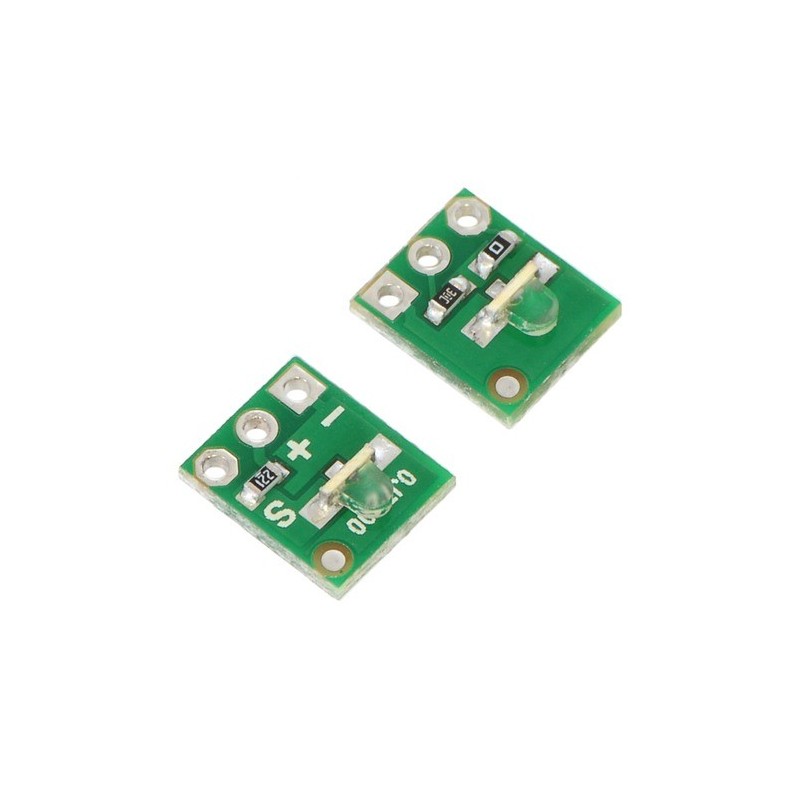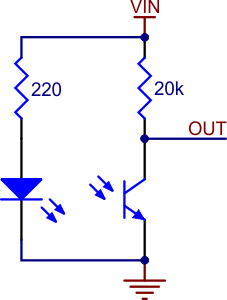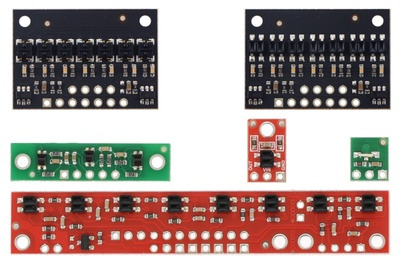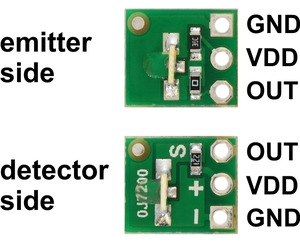

The QTR-L-1A reflectance sensor incorporates a right-angle infrared LED and a right-angle phototransistor in an inexpensive, tiny 0.35" A— 0.3" module that can be mounted almost anywhere and is great for edge detection and line following. The reflectance measurement is output as an analog voltage. This sensor is sold in packs of two units.
Note: The QTR-L-1A reflectance sensor requires an analog input to take readings. The similar QTR-L-1RC reflectance sensor is available with a digital I/O-compatible output.
 |
The Pololu QTR-L-1A reflectance sensor carries a right-angle infrared LED and a right-angle phototransistor, both pointing toward the front edge of the board. The phototransistor is connected to a pull-up resistor to form a voltage divider that produces an analog voltage output between 0 V and VIN (which is typically 5 V) as a function of the reflected IR. Lower output voltage is an indication of greater reflection.
The LED current-limiting resistor is set to deliver approximately 17 mA to the LED when VIN is 5 V. The current requirement can be met by some microcontroller I/O lines, allowing the sensor to be powered up and down through an I/O line to conserve power.
This sensor was designed to be used with the board perpendicular to the surface being sensed, and narrow-angle lenses built into the infrared LED and phototransistor packages allow it to be effective to a range of about 1" (25 mm). Because of its small size, multiple units can easily be arranged to fit various applications such as line sensing and proximity/edge detection. The QTR-L-1A is sold in packs of two units.
For a similar sensor that can be used with the board parallel to the surface, but with shorter range, please see the QTR-1A reflectance sensor. We also offer arrays of three and eight sensors: the QTR-3A reflectance sensor array and the QTR-8A reflectance sensor array.
 |
| QTR sensor size comparison. Clockwise from top left: QTR-3RC, QTR-1RC, QTR-L-1RC, QTR-8RC. |
|---|
 |
There are several ways you can interface with the QTR-L-1A output:
This last method will work if you are able to get high reflectance from your white surface (so that there is a large output voltage difference over black and white surfaces), but will probably fail if you have a lower-reflectance signal profile. The following table shows some typical output voltages from the sensor over different surfaces and at different distances:
| White surface | 3/4" black electrical tape | |
|---|---|---|
| 0.25" distance | 0.2 V | 3.8 V |
| 1" distance | 2.4 V | 3.5 V |
Ambient light, especially sunlight, can affect the sensor readings significantly. If the output voltage from the QTR-L-1A is consistently low, you might need to add shielding around the sensor or mount it in a different location to reduce interference from outside light sources.
Our Pololu AVR library provides functions that make it easy to use these sensors with our Orangutan robot controllers; please see the QTR Reflectance Sensors section of our library command reference for more information. We also have a Arduino library for these sensors.
Each pack of two reflectance sensors includes sets of straight male header strips and right-angle male header strips, which allow you to mount them in the orientation of your choice. You can also solder wires, such as ribbon cable, directly to the pads for the most compact installation.
|
|
 |
QTR-L-1RC Reflectance Sensor (2-Pack) |
 |
QTR-1A Reflectance Sensor |
 |
Sharp GP2Y0A21YK0F Analog Distance Sensor 10-80cm |
Producent BTC Korporacja sp. z o. o. Lwowska 5 05-120 Legionowo Polska sprzedaz@kamami.pl 22 767 36 20
Osoba odpowiedzialna BTC Korporacja sp. z o. o. Lwowska 5 05-120 Legionowo Polska sprzedaz@kamami.pl 22 767 36 20
Moduł z analogowym czujnikiem TEMT6000. Napięcie na wyjściu zwiększa się wraz ze wzrostem natężenia padającego światła. Czujnik zasilany jest napięciem 5 V
Wielofunkcyny moduł z sensorem optycznym do pomiaru natężenia oświetlenia, koloru padającego światła RGB, odległości od obiektu i detekcji gestów 3D. Adafruit 3595
Moduł z czujnikiem koloru i natężenia światła. Oferuje szeroki zakres wykrywania i dwie diody podświetlające LED. Komunikuje się poprzez magistralę I2C. Pimoroni PIM375
Moduł z 10-kanałowym czujnikiem AS7341 pozwalający na wykrywanie światła w różnych zakresach długości fali (detekcja kolorów). Komunikuje się przez interfejs I2C. Adafruit 4698
Czujnik koloru o zasiegu od 8 do 16 mm. Oferuje 3 tryby pracy i może być zasilany napięciem od 12 do 24 V. DFRobot SEN0506
Moduł z czujnikiem światła TSL25911FN, który umożliwia pomiar zarówno światła widzialnego, jak i podczerwieni. Komunikuje się przez interfejs I2C. Waveshare TSL25911 Light Sensor
Moduł z czujnikiem światła otoczenia VEML6030 o zakresie pomiarowym do 120 000 lx. Umożliwia pomiar światła z 16-bitową rozdzielczością. Komunikacja I2C. SparkFun SEN-15436
Moduł monitora pracy serca oparty na popularnym układzie MAX30101. Płytka wyposażona w złacza zgodne ze standardem Qwiic. SparkFun SEN-16474
SparkFun Spectral Sensor AS7262 to moduł z czujnikiem spektrum, który działa w zakresie światła widzialnego (450-650 nm). Czujnik ten pozwala zmierzyć i scharakteryzować jak badana powierzchnia pochłania lub odbija światło o określonych długościach fali. SparkFun SEN-14347
Brak towaru
Moduł z czujnikiem promieniowania ultrafioletowego (UV) oparty na układzie GUVA-S12D. Pozwala na pomiar promieniowania o długości fali w zakresie 200...370nm. Wyjściem czujnika jest sygnał analogowy. Posiada złącze zgodne ze standardem Gravity. DFRobot SEN0162
Moduł pozwala na pomiar światła o długości fali z zakresu od 320 nm do 560 nm. Zakres pomiarowy mieści się w przedziale 1 - 65535 LUX, zaś komunikacja odbywa się przy użyciu magistrali I2C. modBH1750 (GY-302)
Brak towaru
Moduł z czujnikiem promieniowania ultrafioletowego (UV) oparty na układzie GUVA-S12D. Umożliwia pomiar promieniowania o długości fali w zakresie od 240 do 370 nm. Moduł posiada złącze zgodne z standardem Grove. Seeed Studio 101020043
Brak towaru
Moduł czujnika odległości działający w technologii ToF, zakres działania 1-20 cm (przy zmniejszonej rozdzielczości do 60 cm), rozdzielczość do 1 mm. Komunikacja z czujnikiem poprzez magistralę I2C. Zasilanie poprzez wbudowany regulator napięciem od 2,7 do 5,5 V. Pololu 2489
Moduł z 11-kanałowym czujnikiem AS7341 pozwalający na wykrywanie światła w różnych zakresach długości fali (detekcja kolorów). Komunikuje się przez interfejs I2C. Waveshare AS7341 Spectral Color Sensor
Brak towaru
Moduł z czujnikiem światła VEML7700. Pozwala na pomiar natężenia w zakresie od 0 do 120 Klx. Wyposażony w złącze STEMMA QT, komunikuje się przez interfejs I2C. Adafruit 5378
Moduł czujnika światła oparty o fotodiodę, wyposażony w komparator, zgodny z RoHS

